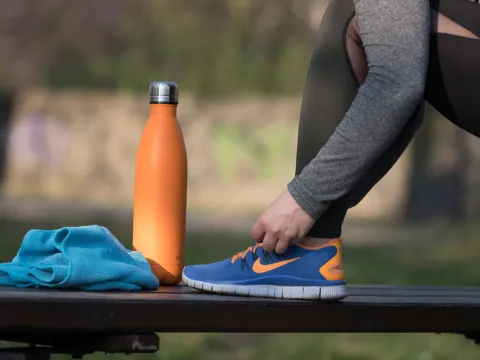Saving More Money Tops New Year’s Resolutions, New Saint Leo University Polling Shows
Losing Weight, Exercising More, and Traveling More Also Popular Goals for 2022

Losing Weight, Exercising More, and Traveling More Also Popular Goals for 2022

There’s still time to make a plan and set some goals for 2022! When it comes to making New Year’s resolutions, usually “losing weight” tops the list. However, a new Saint Leo University Polling Institute (polls.saintleo.edu) survey shows “saving more money” is the most popular resolution among poll respondents.
Polling was conducted online October 17-23, among 1,000 total respondents nationally. The resulting margin of error for the results is 3.0 percentage points in either direction. In Florida, where Saint Leo’s residential campus is located, 500 additional people were polled. The margin of error for the responses is plus or minus 4.5 percentage points.
One-third of all Americans surveyed, 32.4 percent, noted they will make resolutions for 2022. Favorite resolutions continue to be saving more money, losing weight, exercising more, and traveling more.
Those saying they would make resolutions were asked to name their goals for 2022. Results are shown in the following table in declining order by the national 2021 column. Multiple responses were accepted.
|
New Year Resolution(s) |
National 2017 - % |
National 2019 - % |
National 2021 - % |
Florida 2017 - % |
Florida 2019 - % |
Florida 2021 - % |
|
Save more money |
56.0 |
53.4 |
59.0 |
54.7 |
52.3 |
51.0 |
|
Lose weight |
55.7 |
50.0 |
37.7 |
52.5 |
49.4 |
42.1 |
|
Exercise more |
27.2 |
34.2 |
33.6 |
23.2 |
34.5 |
29.7 |
|
Travel more |
29.5 |
29.5 |
27.2 |
34.3 |
35.1 |
28.7 |
|
Vacation more |
29.9 |
22.9 |
26.2 |
24.3 |
22.4 |
30.7 |
|
Spend more time with family |
26.5 |
29.1 |
25.0 |
25.4 |
24.7 |
30.7 |
|
Find a new job |
27.5 |
28.1 |
21.6 |
27.1 |
21.8 |
21.8 |
|
Buy a new car / new house |
19.8 |
15.8 |
19.8 |
18.2 |
12.6 |
19.3 |
|
Stop smoking |
8.7 |
6.8 |
13.9 |
9.4 |
7.5 |
13.9 |
|
Find a wife/husband – get married |
11.7 |
7.5 |
13.3 |
12.2 |
14.9 |
13.9 |
|
Give more to charities |
11.4 |
11.6 |
12.3 |
10.5 |
13.8 |
7.9 |
|
Volunteer more time |
14.4 |
12.0 |
11.1 |
13.8 |
16.1 |
14.4 |
|
Join a gym |
14.8 |
14.4 |
10.2 |
13.3 |
16.1 |
13.4 |
|
Drink less alcohol |
8.7 |
9.9 |
9.9 |
7.2 |
6.3 |
15.8 |
|
Attend religious services or attend more often |
13.8 |
12.7 |
9.6 |
11.0 |
12.6 |
14.4 |
|
Spend less time with family |
4.4 |
3.4 |
5.2 |
2.8 |
2.3 |
3.5 |
|
Stop vaping |
--- |
3.1 |
3.4 |
--- |
3.5 |
5.0 |
|
Take steps to renew friendships lost over political disagreements |
--- |
--- |
3.4 |
--- |
--- |
5.4 |
|
Attempt constructive, polite engagement with those holding different political views/philosophy |
--- |
--- |
1.9 |
--- |
--- |
4.0 |
Among the national poll respondents, those ages 18 to 44 were most likely to make resolutions for 2022 at 50.1 percent, following by those 45-64 at 18.4 percent, and those 64 and older at 6.9 percent.

Dr. Christopher Wolfe, associate professor of psychology at Saint Leo University, said age may make a difference in the choice of which resolutions to make. “As saving more money is also the most popular option, I might guess that this age group suffered the most significant changes to their home, work, and school lives over the course of the past two years [due to the COVID-19 pandemic],” Wolfe said. “A humanist perspective would see this as a sign of hope—a core personality characteristic among successful and mentally healthy individuals.
“While the current struggles have been trying, a resolution to make a change, to try and better one’s life in some measurable way, demonstrates recognition of deficit and a willingness to create a plan or goal,” he continued. “These are two key aspects of embracing a healthy view on self, stress, and the world. It is; however, the third component—motivation—that often breaks the New Year’s resolve and undermines even the best intentions for improvement.”
Wolfe said money was “real tight or simply disappeared these past two years for many Americans.
“Most particularly for those in low paying, service, and gig-based jobs—those more common among the 18-44 crowd,” he said. “Perhaps this represents a wake-up call and a larger push to start building a ‘safety net’ in case—or when—another pandemic rips the framework of our lives apart.”
Reducing Resolutions
Saint Leo University’s poll shows a drop in the percentage of those who say they will resolve to lose weight. Wolfe said many people have gym memberships, but never use them. A recent international psychological study tested multiple interventions to try to get people to use those memberships.

“The primary outcome suggested the most effective way to get folks back in the gym was to make a plan, set reminders, and for the gym to offer incentives/programs, etc., to keep folks engaged,” Wolfe said. “In other words, do a lot of work in [yourself] to remember you need to go work out. This lack of motivation coupled with the added stress of supporting your own drive may be behind why a drop in the amount of folks reporting they would resolve to lose weight. Frankly, when the it takes extra work to do the work, that drops many people off the sign-up sheet.”
COVID-19 also may play in part in less people selecting weight loss as a goal. “Losing weight may have become less popular as a resolution after two years of not seeing other people,” Wolfe said. “With fewer reasons and places to go out, perhaps the social pressure to meet an ideal body image has moved to a lesser, secondary, position in the lives of Americans. I would guess that worrying about one’s body image, or more seriously their health, has become less of a focus as we have seen more Americans struggling to keep a job, their kids safe, and food on the table.”
Wolfe advised that those with plans for change let people around them know about chosen New Year’s resolutions. “As spending money on friends and family may be one of the areas folks choose to cut, letting them in on your goal will save you from explaining why you’re not coming out to party on New Year’s and will instead be keeping your ‘pudgy-not resolving to lose weight’ self on the couch,” he said.
About the Poll
METHODOLOGY: This national survey was conducted from October 17, 2021, through October 23, 2021, among a base of 1,000 respondents nationally, using an online instrument. The national sample has an associated margin of error of +/- 3.0 percentage points at a 95 percent confidence for questions asked of all 1,000 respondents.
The statewide survey was also conducted during the same time period, among a base of 500 respondents, using an online instrument. The sample has an associated margin of error of +/- 4.5 percentage points at a 95 percent confidence for questions asked of all 500 respondents.
The Saint Leo University Polling Institute conducts its surveys using cutting-edge online methodology, which is rapidly transforming the field of survey research. The sample is drawn from large online panels, which allow for random selections that reflect accurate cross sections of all demographic groups. Online methodology has the additional advantage of allowing participants to respond to the survey at a time, place, and speed that is convenient to them, which may result in more thoughtful answers. The Saint Leo University Polling Institute develops the questionnaires, administers the surveys, and conducts analysis of the results. Panel participants typically receive a token incentive—usually $1 deposited into an iTunes or Amazon account—for their participation.
The Saint Leo University Polling Institute survey results about national and Florida politics, public policy issues, Pope Francis’ popularity, and other topics, can also be found here: http://polls.saintleo.edu. You can also follow the institute on Twitter @saintleopolls.